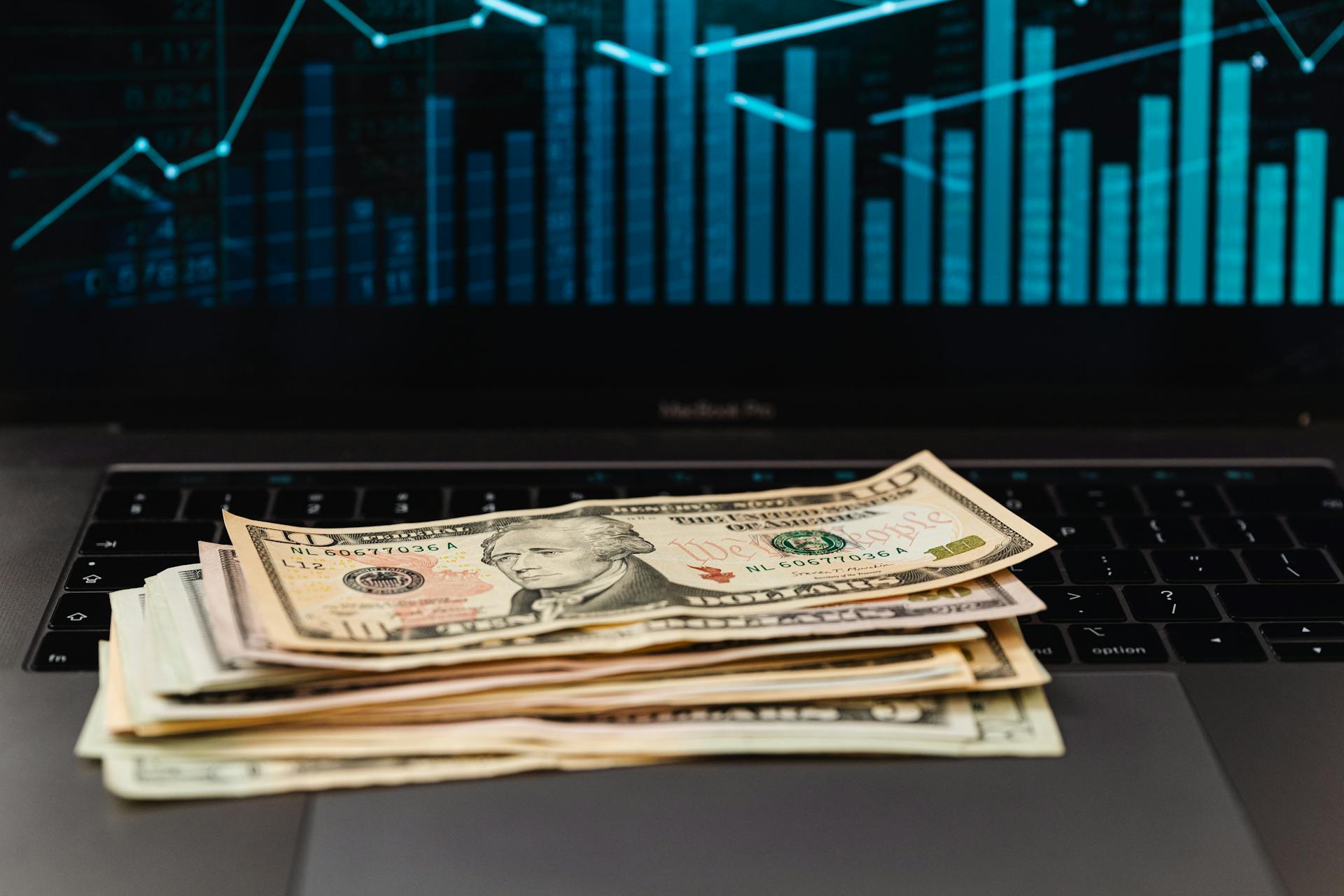
The nominal yield is the actual return on investment you receive from a bond, taking into account compounding periods and the time value of money.
It's essential to understand that nominal yield is not the same as the coupon rate or current yield. The coupon rate is the interest rate paid periodically, while the current yield is the ratio of the annual income to the current market price.
A nominal yield of 5% means you'll earn 5% interest on your investment, but the actual return will be more due to compounding.
As you can see, the nominal yield is a critical concept in investing, and it's not just about the interest rate.
Curious to learn more? Check out: Coupon Meaning Finance
What Is Nominal Yield?
The nominal yield is a fixed percentage that a bond issuer promises to pay bond purchasers. It's essentially the interest rate that the bond issuer promises to pay, and it applies to the life of the bond.
This rate is determined at the time the bond is issued and does not change over the life of the bond. It's a reliable, though not entirely accurate, measure of a bond's profitability.
The nominal yield is often referred to as the 'coupon rate' or 'interest rate'. It's expressed as a percentage of the bond's face value, and it's a key factor in determining the bond's value.
For example, a bond with a face value of $1,000 that pays the bondholder $50 in interest payments annually would have a nominal yield of 5%. This is calculated by dividing the annual interest payment by the face value of the bond.
The nominal yield does not take into account the effect of inflation, reinvestment of interest, or any potential capital gains or losses. This means that it's not always a perfect measure of a bond's profitability, but it's still a useful tool for investors.
Here's a breakdown of how the nominal yield works in different scenarios:
- If the bondholder bought the bond for $1,000, the nominal yield and the current yield are the same, 5%.
- If the bondholder paid a premium and bought the bond at $1,050, the nominal yield is still 5% but the current yield would be 4.76% (50/1050).
- If the bondholder got the bond at a discount and paid $950, the nominal yield is still 5% but the current yield would be 5.26% (50/950).
Calculating Nominal Yield
Calculating Nominal Yield is a straightforward process, but it's essential to get it right. The calculation of nominal yield in annual terms is done by adding all the bond payments made during the year.
To calculate the total amount of bond payments, you need to know the frequency of the payments and the amount of each payment. For example, if it's a semi-annual paying bond, you'll need to multiply the semi-annual payment by 2 to get the total annual payment.
The total amount of bond payments is then divided by the face or par value of the bond. This will give you the nominal yield as a decimal, which can be converted to a percentage by multiplying by 100.
For instance, if a bond has a face value of $1,000 and makes $25 semi-annual payments, the total annual payment would be $50. Dividing $50 by $1,000 gives a nominal yield of 0.05, which is equivalent to 5%.
See what others are reading: Redemption Value
Here's a simple formula to calculate nominal yield:
Nominal Yield = Annual Interest Payment/Bond's Face Value
For example, if a bond pays an annual coupon of $50 and has a face value of $1,000, the nominal yield would be 5% (50/1000).
It's worth noting that the nominal yield may not accurately reflect the bond's true yield to maturity, especially if the market price of the bond fluctuates.
Additional reading: Bond Trade Value Goes down as Maturity Aproaches
Factors Influencing Nominal Yield
Inflation is a key driver of nominal yield, as it erodes the purchasing power of investors. The nominal rate is directly tied to the inflation rate, which means that if inflation is high, the coupon rate needs to be higher to compensate investors.
High inflation can make it difficult for investors to make ends meet, so a higher coupon rate is necessary to keep up with the rising cost of living. This is why bond issuers take inflation into account when determining the coupon rate.
Discover more: Realtions of Bond Coupon Rate to Yield Rate
The credit risk of the issuer is another important factor influencing nominal yield. If an issuer has a high credit risk, investors demand a higher coupon rate to compensate for the risk of not receiving contractual cash flows.
Bondholders who doubt an issuer's trustworthiness may miss out on payments, making it essential to factor in credit risk when determining the nominal rate. A higher credit risk means a higher coupon rate is needed to incentivize investors to take on that risk.
Take a look at this: Zero Coupon Bond Yield to Maturity
Nominal Yield in Bond Pricing
A bond's nominal yield plays a key role in bond pricing, with bonds having higher nominal yields tending to have higher prices, all else being equal.
The nominal yield represents the fixed annual income that a bondholder will receive, and investors are generally willing to pay more for bonds that offer higher income. This is because the higher yield is often a compensation for higher risk.
Here are some key facts about nominal yield in bond pricing:
- Nominal yield is calculated by dividing total interest paid annually by the face, or par, value of the bond.
- Two components combine to determine the nominal yield on a debt instrument: the prevailing rate of inflation and the credit risk of the issuer.
In reality, many bondholders reinvest their coupon payments, which can significantly increase their total return. This is known as the yield to maturity (YTM), which is considered a more accurate measure of a bond's return.
Role in Bond Pricing
The nominal yield plays a key role in bond pricing. It's a crucial factor that investors consider when deciding whether to buy a bond.
Bonds with higher nominal yields tend to have higher prices, all else being equal. This is because the nominal yield represents the fixed annual income that a bondholder will receive, and investors are generally willing to pay more for bonds that offer higher income.
However, the relationship between nominal yield and bond price is not always straightforward. Other factors, such as changes in interest rates, credit risk, and liquidity risk, can also affect bond prices.
Here's a breakdown of the components that combine to determine the nominal yield on a debt instrument:
- The prevailing rate of inflation
- The credit risk of the issuer
Keep in mind that the nominal yield does not always represent the current yield because it is a percentage based on the bond's par value and not the actual price that was paid for that bond.
Reinvestment of Interest
The nominal yield assumes that the annual coupon payments are not reinvested, which is a significant limitation.
This assumption doesn't reflect the compounding effect of reinvesting the coupon payments, which can significantly increase a bondholder's total return.
In reality, many bondholders reinvest their coupon payments, which can lead to a higher total return than the nominal yield.
For example, if a bondholder reinvests their annual coupon payments at the same rate as the nominal yield, their total return would be higher than the nominal yield.
This is known as the yield to maturity (YTM), which is considered a more accurate measure of a bond's return.
Frequently Asked Questions
What is the difference between nominal yield and running yield?
The key difference between nominal yield and running yield is that nominal yield is based on the bond's face value, while running yield uses the current market price. This distinction affects the actual yield you receive from the bond, making running yield a more accurate reflection of its true return.
Sources
- https://corporatefinanceinstitute.com/resources/career-map/sell-side/capital-markets/nominal-yield/
- https://tiomarkets.com/en/article/nominal-yield-guide
- https://www.wallstreetmojo.com/nominal-yield/
- https://www.investopedia.com/terms/n/nominalyield.asp
- https://www.stockgro.club/learn/share-market/nominal-yield/
Featured Images: pexels.com


